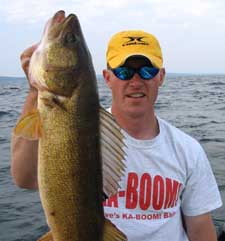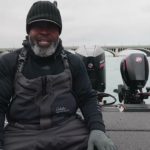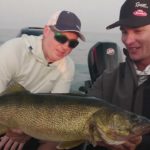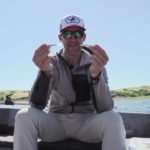Give Me A Break! Walleyes and Current Breaks in Rivers
Give me a Break! Remember that old TV show with Nell Carter? Nell was a fairly large woman and a pretty good example of what most of us look for in a big female walleye. In this article I hope to explain how walleyes grow to be Nell-sized by utilizing current breaks in the rivers they inhabit.
 First of all you have to understand what a current break is and how it offers a feeding opportunity to a walleye. A current break is an area where the current in a river is diverted in a way that creates slack water near a piece of structure. The slack water offers a holding place for a walleye where they don’t have to expend much effort to stay in one place, while also allowing the fish to ambush any prey washing by with the main current. This strategy reduces the energy a fish needs to spend and maximizes it’s potential to grow fat and happy. These pieces of structure can be on a scale as small as a single rock to as large as the deepest hole in the river. Identifying these structures can help you eliminate dead stretches of river and focus your time in the most likely places to find fish.
First of all you have to understand what a current break is and how it offers a feeding opportunity to a walleye. A current break is an area where the current in a river is diverted in a way that creates slack water near a piece of structure. The slack water offers a holding place for a walleye where they don’t have to expend much effort to stay in one place, while also allowing the fish to ambush any prey washing by with the main current. This strategy reduces the energy a fish needs to spend and maximizes it’s potential to grow fat and happy. These pieces of structure can be on a scale as small as a single rock to as large as the deepest hole in the river. Identifying these structures can help you eliminate dead stretches of river and focus your time in the most likely places to find fish.
Major structural elements in a river that create current breaks include points, wing dams, eddies, backwaters and deep holes. The diagram shows a cross section view of how current is diverted by a wing dam or a point extending into the main channel.
Walleyes will hold in the areas of slack water without expending much energy and wait for the current to wash food past them. The rock structure on the top of the wing dam creates a slipstream behind it where fish can hold, and the same is true of the downstream side of the wing dam. The upstream side, or face, of the wing dam also provides a place for fish to hold and is often the most productive area on the dam or point. The current follows the path of least resistance, which is out into the main channel away from the tip of the structure or over the top of the dam where the flow is constricted. The increased velocity of the current over the top will create a riffle on the surface of the water which you can see, but be careful when navigating near the top of a wing dam and remember that the riffle occurs slightly downstream of the feature which caused it.
 Deep holes offer the same kind of slack areas as a wing dam. For an extreme example think of the way a waterfall flows over a cliff. There is a void behind the waterfall where you might be able to walk and watch the water flow over the top of you. The momentum of the current carries it over your head before it drops down and begins to scour the bottom of the hole. The same kind of void is created in miniature at the upstream lip of a hole in a river, although the more abrupt the drop into the hole – the better. The tail end of the hole is influenced in much the same way as the face of a wing dam, and creates another area for walleyes to hold. The center stretch of a hole is also an area of reduced current velocity due to the increase in depth. Water depth and current velocity are inversely proportional; meaning that if one goes up the other must come down. Deep holes and bends offer places for fish to rest and conserve their energy when they aren’t feeding as actively near the head or tail end of the hole.
Deep holes offer the same kind of slack areas as a wing dam. For an extreme example think of the way a waterfall flows over a cliff. There is a void behind the waterfall where you might be able to walk and watch the water flow over the top of you. The momentum of the current carries it over your head before it drops down and begins to scour the bottom of the hole. The same kind of void is created in miniature at the upstream lip of a hole in a river, although the more abrupt the drop into the hole – the better. The tail end of the hole is influenced in much the same way as the face of a wing dam, and creates another area for walleyes to hold. The center stretch of a hole is also an area of reduced current velocity due to the increase in depth. Water depth and current velocity are inversely proportional; meaning that if one goes up the other must come down. Deep holes and bends offer places for fish to rest and conserve their energy when they aren’t feeding as actively near the head or tail end of the hole.
Minor structural elements that create current breaks are almost too numerous to list, but include individual rocks, trees, rip rap, docks, washboards, clam beds and bridge piers. Any of these structures could divert enough flow for one or maybe a few fish to lay in wait. These are spot on the spots and will take some searching to find, but the principle remains the same. Any place that a walleye can minimize the energy spent holding while maximizing the opportunity to feed will be a place worth fishing.
As a general rule you will find sauger holding in areas with higher current velocities than walleyes are willing to tolerate. On some current breaks you will find sauger and walleye within a few feet of each other, but almost always the sauger will be holding close to the fastest current and the walleye will be nearby holding in the more slack water. Sauger are usually much thinner than walleye, and that fact illustrates the somewhat lazy but effective strategy of walleye conserving more energy by avoiding strong currents.
The spring migration of walleyes upstream to spawn is another example of how important current breaks are. A spawning walleye needs to get upstream with the least effort possible and will seek out the path of least resistance. This means traveling from current break to current break to rest and feed while continuing upstream through water with the least velocity. The inside of bends in a river offer shelter from the swift current found in the main channel racing around the outside of a corner, and is often an overlooked place for spring eyes. It’s not really fair to call walleyes lazy for this behavior; after all it conserves energy and puts more meat on your table or a bigger gut on the fish in your pictures.
So pay attention to any structure that you find in a river and try to figure out how you would use it to your advantage if you were hungry and didn’t want to work that hard for your next meal. That strategy of survival has kept walleyes alive as a species for a long time.





